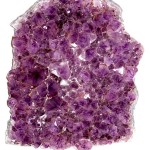My amethyst blog entry generated an interesting question, asking more about quartz. I’m betting that lots of people would like to know more about it, so instead of detailing another gemstone this time, I’m sharing my quartz answer.

Amethyst Geode
I’m not going to go into the geology of it all, but there are basically two types of quartz – those with large crystals that we can easily see with our naked eyes, and those with crystals so small they require a microscope to see them. The first group has some familiar gemstones like amethyst, citrine, aventurine, tiger eye, smoky quartz, and rose quartz.
The second group, quartzes with small crystals, are commonly called chalcedony. This is a large group that includes agates, jaspers, onyx, bloodstone, carnelian, and stones simply referred to by their color names – blue, purple, pink, and green chalcedony. It is these latter stones that are now most often seen in imitation glass versions. The pretty blue “quartz” and cherry “quartz” that are readily available are actually colored glass. Beware when buying them to make sure you’re getting what you’re paying for.
But from my perspective, what’s most interesting is that so many of the stones that I work with, from amethyst to Botswana agate, red jasper to onxy, are all forms of quartz! They look so different, that I didn’t know the geology behind them was so similar. Guess I should have paid more attention in that college geology class!


Leave a Reply